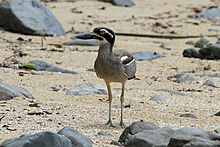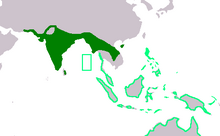The beach stone-curlew (Esacus magnirostris) also known as beach thick-knee is a large, ground-dwelling bird that occurs in Australasia, the islands of South-east Asia. At 55 cm (22 in) and 1 kg (2.2 lb), it is one of the world's largest shorebirds.
| Beach stone-curlew | |
|---|---|

| |
| Scientific classification | |
| Domain: | Eukaryota |
| Kingdom: | Animalia |
| Phylum: | Chordata |
| Class: | Aves |
| Order: | Charadriiformes |
| Family: | Burhinidae |
| Genus: | Esacus |
| Species: | E. magnirostris
|
| Binomial name | |
| Esacus magnirostris (Vieillot, 1818)
| |

| |
E. magnirostris range E. recurvirostris range
| |
| Synonyms | |
|
Esacus neglectus | |
It is less strictly nocturnal than most stone-curlews, and can sometimes be seen foraging by daylight, moving slowly and deliberately, with occasional short runs. It tends to be wary and fly off into the distance ahead of the observer, employing slow, rather stiff wingbeats..
The beach stone-curlew is classified as Near Threatened on the IUCN Red List of Threatened Species. In New South Wales it is listed as critically endangered.[2]
Distribution edit
The beach stone-curlew is a resident of undisturbed open beaches, exposed reefs, mangroves, and tidal sand or mudflats over a large range, including coastal eastern Australia as far south as far eastern Victoria, the northern Australian coast and nearby islands, New Guinea, New Caledonia, Indonesia, Malaysia, and the Philippines. It is uncommon over most of its range, and rare south of Cairns.
Description edit
The beach stone-curlew is 54-56 cm (21-22 in) long. At a mean of 1,032 g (2.275 lb) in males and 1,000 g (2.2 lb) in females, it is the heaviest living member of the Charadriiformes outside of the gull and skua families.[3][4] They have black and white face patterning, yellow eyes and a grey-brown upper body.
Ecology edit
Beach stone-curlew forage on low tide muddy sand for invertebrates, mostly crabs.[5][6]
Breeding edit
The bird breeding season is September to November. The bird nests in sand, laying one egg per season just above the high tide line on the open beach, where it is vulnerable to predation and human disturbance.[7] The egg is vulnerable to Both parents care of the young until they reach 7-12 months of age.[6][8][7]
Call edit
As an alarm, the bird will make a chwip-chwip to ward creatures away from their territory.[7]
Gallery edit
-
At Inskip Point, SE Queensland, Australia
-
On Green Island off Cairns
-
At Cape Tribulation, north Queensland, Australia
References edit
- ^ BirdLife International (2016). "Esacus magnirostris". IUCN Red List of Threatened Species. 2016: e.T22728621A94992570. doi:10.2305/IUCN.UK.2016-3.RLTS.T22728621A94992570.en. Retrieved 12 November 2021.
- ^ "Esacus magnirostris — Beach Stone-curlew". Species Profile and Threats Database.
- ^ CRC Handbook of Avian Body Masses, 2nd Edition by John B. Dunning Jr. (Editor). CRC Press (2008), ISBN 978-1-4200-6444-5.
- ^ "Esacus magnirostris (Beach Thick-knee) - Avibase". avibase.bsc-eoc.org. Retrieved 2024-05-25.
- ^ "Beach Stone-curlew | BIRDS in BACKYARDS". www.birdsinbackyards.net. Retrieved 2024-05-25.
- ^ a b "Beach Stone-curlew". The Australian Museum. Retrieved 2024-05-25.
- ^ a b c https://www.lls.nsw.gov.au/__data/assets/pdf_file/0003/1325298/BeachStoneCurlew-web.pdf Threatened Fauna of the Hunter & Mid Coast
- ^ Garnett, Stephen; Franklin, Donald, eds. (2014). Climate Change Adaptation Plan for Australian Birds. CSIRO Publishing. ISBN 978-0-643-10803-5.
